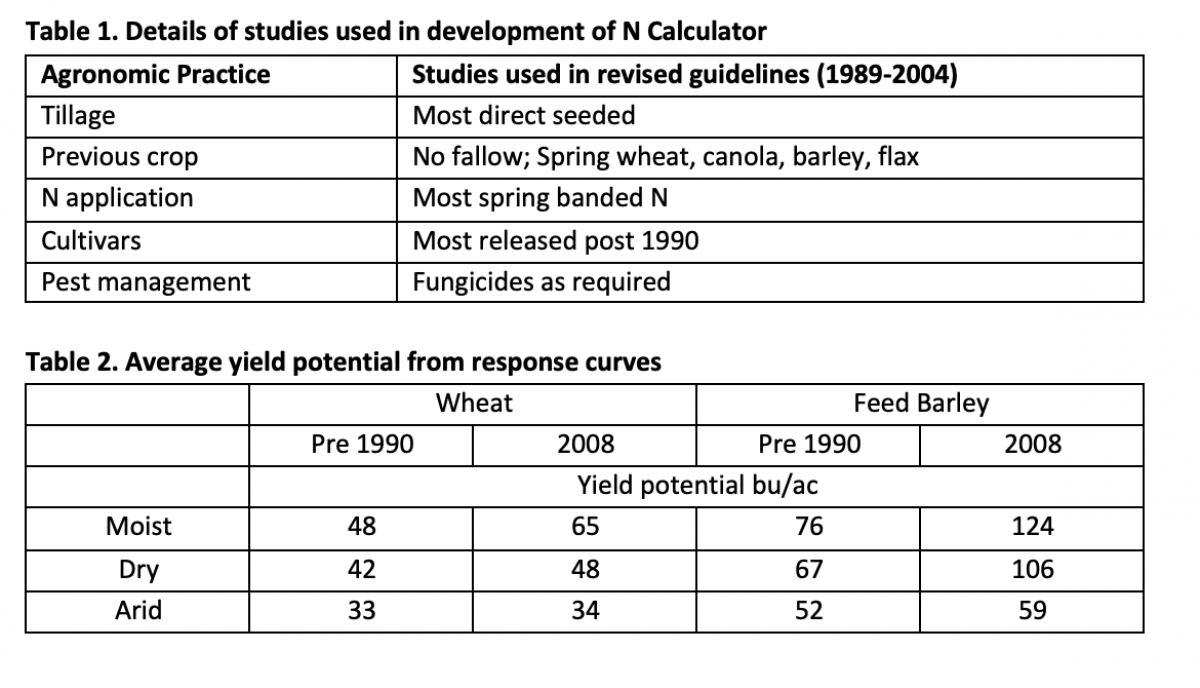Nitrogen calculators for Black, Dark Brown and Brown soil
The Alberta Wheat and Barley Commissions wanted a tool to help growers understand possible economic returns when nitrogen (N) fertilizer and crop prices are extremely high. These N Rate Calculators, developed by Rigas Karamanos, Ph.D., P.Ag., FCSA, for spring wheat and feed barley are Excel spreadsheets that can be used to evaluate different net return per acre scenarios which compare different N sources and costs, various crop prices and soil test N levels (nitrate-N in lb/ac to 24"). The user has the option of changing fertilizer source, cost, crop price, N fertilizer rate and soil test N (any yellow cells). The calculator determines the N fertilizer amount with the maximum net returns (cells are highlighted in blue).
Nitrogen Calculator Black SoilThis tool was developed based on an existing tool that was presented in March 2006 at the Saskatchewan Soils and Crops Meeting1 and subsequently at the Manitoba Soil Fertility Advisory Committee “The revised N rate guidelines for spring wheat, barley and canola”2. In February 2021, the tool was updated by Dr. Rigas Karamanos for Alberta conditions in the Black, Dark Brown and Brown Soil Zones. Unfortunately, insufficient research data from the Grey soil zones prevented the development of this tool for Grey soil types.
Below are video demonstrations from Agronomy Research Extension Specialist, Jeremy Boychyn, showing how to use the Nitrogen Rate Calculators.
Part 1: Introductions, Warnings and Assumptions
Part 3: Exploring Multiple Scenarios with the Calculator
Following is a brief description of the data used to develop the N calculator, the equations used in the calculator and the economic analysis.
1. Research studies used to develop the N Calculator
The studies used to develop the N calculator employed agronomic practices that are typical of Western Canada and contribute to high yield (Table 1). The yield potential for each crop used in these research studies are listed in Table 2.

2. Data and development of N guidelines
The individual site yield data was plotted against total N (soil nitrate-N plus fertilizer N) and the average yield increase was characterized using the quadratic response function. The response equations are listed below.
In these equations (Y = a + bx + cx2):
Y = yield increase in bu/ac
x = lb soil + fertilizer N
a = the yield with no applied N fertilizer
b = the upward slope of the yield response
c = the rate at which the response diminishes, eventually flattens out and declines
Spring Wheat Quadratic Response Equations
Black Soils (102 sites), y = - 6.464 + 6.644x - 0.18x2 R2 = 0.9980
Dark Brown Soils (42 sites), y = - 1.2298 + 8.722x - 0.3438x2 R2 = 0.9771
Brown Soils (24 sites), y = - 1.0761 + 7.6317x - 0.3008x2 R2 = 0.9715
Feed Barley Quadratic Response Equations
Black Soils (118 sites), y = - 10.855 + 11.135x - 0.28x2 R2 = 0.9890
Dark Brown Soils (52 sites), y = - 0.4072 + 9.7514x - 0.3253x2 R2 = 0.9825
Brown Soils (12 sites), y = - 0.3563 + 8.5324x - 0.2846x2 R2 = 0.9825
3. Fertilizer economic analysis
Recent fluctuations in crop prices and N costs prompted the presentation of the calculator in a format that allows the user to contrast different crop price to N fertilizer cost ratios.
This Excel based N Calculator, modified for Black, Dark Brown and Brown Soil zones for wheat and barley was built by Karamanos, 20061, and provides a spreadsheet method to interactively display different crop price and fertilizer cost options. Economic return comparisons to N fertilization are based on the principle of net return as described by University of Wisconsin Professor M. Rankin (Rankin, 20103).
The use of this calculator requires a change in thinking. The grower does not set a yield goal, but selects their soil type. The maximum economical return to N is not based on yield goal, but is determined from the yield increase above where no N is applied. The total return is also supplied for reference and comparison purposes.
For example, on a black soil with 20 lbs of residual N, based on historical on-farm knowledge, applying zero N fertilizer would historically yield 40 bu/ac (note this value is not given in the calculator) and application of 100 lbs of N/ac is anticipated to produce an extra 37.6 bu/ac, the expected yield would be 40 bu/ac + 37.6 bu/ac = 77.6 bu/ac with the addition of 100 lbs N/ac.
Growers may wish to exercise risk management in these fertilizer rate decisions. Reasons include:
1. High levels of production risk may make it unlikely to achieve the yield increases illustrated in the calculator. These production risks include:
• variable fields
• poor drainage
• risk of severe drought
• risk of early frost
• inability to provide optimum pest management
• delayed seeding
2. Economic risks include:
• high interest rates
• high input carrying charges
• highly leveraged
In order to reduce the financial risk of fertilizing with high rates of N and not achieving these returns, you can demand a greater return on the last dollar spent on N fertilizer. This is determined by the marginal revenue which equals the marginal return to marginal cost ratio. The maximum economic N rate occurs when the last increment (or dollar) spent on N returns a dollar value of crop.
References
1 Karamanos et al. 2006. Agronomic and Economic Benefits of Fertilizing Crops. Soils and Crops 2006, March 1-2, Extension Division, University of Saskatchewan, Saskatoon, SK

